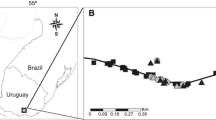Abstract
Although the garden tomato is very highly self-polli nated in most regions of cultivation, it is cross-pollinated at much higher rates in the range of its wild relatives— Ecuador, Peru, and northern Chile. Cohabitation of garden tomatoes and an intercompatible species in this region permits extensive gene exchange between them. These factors lead to a high level of variability and promote rapid evolution of new forms.
Similar content being viewed by others
Literature Cited
Cobo, Fr. Bernabe. 1891–1893. Historia del nuevo mundo 4: 26. Seville.
Guaman Pomo de Ayala, Felipe. 1587. El primer nueva coronica i buen gobierno. La Paz, Bolivia.
Hoover, M. M., L. J. Alexander, E. F. Paddock, and A. F. Dodge. 1955. Horticultural characters and reaction to two diseases of theLycopersicon accessions in the North Central Region. Ohio Agric. Expt. Sta. Res. Bui. 65. [19 pp.]
Howlett, F. S. 1939. The modification of flower structure by environment in varieties ofLycopersicum esmlentum. Jour. Agr. Res. 58: 79–117.
Jenkins, J. A. 1948. The origin of the cultivated tomato. Eco. Bot. 2: 379–392.
Lindstrom, E. W., and L. M. Humphrey. 1933. Comparative cyto-genetic studies of tetraploid tomatoes from different origins. Genetics 18: 193–209.
MacArthur, J. W., and L. P. Chiasson. 1947. Cytogenetic notes on tomato species and hybrids. Genetics 32: 165–177.
Midler, C. H. 1940. A revision of the genusLycopersicon. U.S.D.A. Misc. Publ. 382. [29 pp.]
Richardson, R. W., Jr., and E. Alvarez L. 1957. Pollination relationships among vegetable crops in Mexico. I. Natural cross-pollination in cultivated tomatoes. Proc. Amer. Soc. Hort. Sci. 69: 366–371.
Rick, C. M. 1949. Rates of natural cross- pollination of tomatoes in various localities in California as measured by the fruits and seeds set on male-sterile plants. Proc. Amer. Soc. Hort. Sci. 54: 237–252.
—. 1950. Pollination relations ofLycopersicon esculentum in native and foreign regions. Evolution 4: 110–122.
—. 1956. Genetic and systematic studies on accessions ofLycopersicon from the Galápagos Islands. Amer. Jour. Bot. 43: 687–696.
—and L. Butler. 1956. Cytogenetics of the tomato. Advances in Genetics 8: 267–382.
— and R. Lamm. 1955. Biosystematic studies on the status ofLycopersicon chilense. Amer. Jour. Bot. 42: 663–675.
Sawant, A. C. 1958. Cytogenetics of interspecific hybrids,Lycopersicon esculentum Mill, xLycoperiscon hirsutum Hum. and Bonpl. Genetics 43: 502–514.
Vavilov, N. I. 1949. The origin, variation, immunity, and breeding of cultivated plants. Selected writings translated from the Russian by K. S. Chester. Chron. Bot. 13: 1–364.
Author information
Authors and Affiliations
Additional information
Part of the information submitted here was collected in South America during the tenure of a John Simon Guggenheim Memorial Fellowship (1948–49). Additional studies on a second trip in 1956–57 were partly supported by research grant No. GA-AGR-5547 from the Rockefeller Foundation. The privilege of such support is gratefully acknowledged. It is also a pleasure to express appreciation for the help of many friends in South America, the list of whose names would fill several pages.
Rights and permissions
About this article
Cite this article
Rick, C.M. The role of natural hybridization in the derivation of cultivated tomatoes of western south America. Econ Bot 12, 346–367 (1958). https://doi.org/10.1007/BF02860023
Issue Date:
DOI: https://doi.org/10.1007/BF02860023




